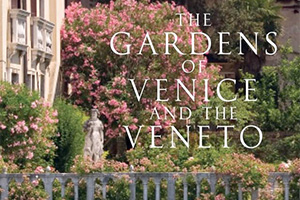The Gardens of Venice and The Veneto
 I love coffee table books, especially when they are about gardens, but in order for them to earn their keep on my coffee table I am looking for something more than a general overview with lots of pretty pictures and lists of plants.
I love coffee table books, especially when they are about gardens, but in order for them to earn their keep on my coffee table I am looking for something more than a general overview with lots of pretty pictures and lists of plants.
In ‘The Gardens of Venice and the Veneto’ author Jenny Condie has produced a first-class book, which definitely earns its keep on that coffee table.
The first to examine in detail the great gardens of the Veneto region and with stunning photographs by acclaimed garden photographer Alex Ramsay, I have found it hard to put down.
What sets this book apart from its contemporaries is the fantastic amount of detail, setting each garden both in its geographical and historical context and introducing us to the fascinating people who created the gardens featured. This well-researched book explains what kind of gardens grew out of the Venetian environment and follows the history of their development, from modest holdings providing food for fisher-folk to the grand villas and parks of the wealthy.
The author explores 20 gardens, three within Venice itself and 17 distributed around the region known as the Veneto. The provinces of Verona, Vicenza, Rovigo, Padua and Treviso are covered and there is one chapter dedicated to the island of the Giudecca, in Venice, where many of Venice’s famous gardens were concentrated and which is still a green retreat.
From one’s armchair you can travel to some of the most sumptuous and architecturally interesting gardens in the region. A Henry James experience lingers and one can almost smell the “perfumes and geography of smells”, the author mentions in the introduction. Her writing style is easy and draws you into each garden immediately.
In the Introduction the author takes us through the development of the gardens in this part of Italy. She points out that as Venice grew and trade prospered, private botanical gardens proliferated such as San Trovaso, remarkable for its rare plants. Veneto’s varied geography, from the Alpine chain in the north to the vast plain towards the Adriatic, plus the area’s proximity to Venice, has endowed the region with unique beauty and diversity, reflected in many of its gardens.
We follow the influences of the Renaissance on gardens as meeting places for members of literary and artistic circles and the role of the convents and monasteries, which were numerous and where extensive gardens could often be found.
The author knows the region well, which is apparent from the depth and authority of her writing. She has lived in Venice for the past ten years and as an art historian she brings that added wealth of knowledge bringing the text alive and stimulating interest.
One can travel in the footsteps of Henry James, Robert Browning and James McNeill Whistler, seeing the vistas they saw and experienced. The garden behind Henry James’s ‘Aspern Papers’ is here along with the garden which so beguiled Margaret Symonds, the young English author of Days Spent on a Doge’s Farm.
Another strength of this book is that there is an emphasis on featuring gardens which can be visited, rather than gardens which may be out of the reach of the normal tourist traveller.
As one might expect there are plenty of photographs of beautiful Italian buildings, garden statuary and balustrades, however, Alex Ramsay’s superb photography draws you into each garden in a vital and familiar way so that by the end of each garden chapter one feels that you have actually visited.
I have always found it irritating when author’s just devote one or two pages to a garden in such publications, and we are left with many more questions than answers – a mere overview and no more. Not so here, Jenny Condie devotes a good deal of text to each garden visited and her writing style sets us into a comfortable mood right from the beginning.
She has featured an eclectic group of gardens from the interesting Villa Valmarna (the Masonic Garden) to the beautiful Villa Pisani at Stra and throughout we are introduced to powerful families whose buildings and gardens shout status. It is a testament to the ability of the region’s architects, gardeners, botanists and sculptors that so many of the places that they imagined into being are still much-treasured artifacts, despite their inherent fragility.
Jenny Condie lives in Venice with her husband, novelist Enrico Palandri and their three children. When not in libraries or exploring gardens, she helps to bring English literature to children in local schools.
Alex Ramsay lives in the Welsh Marches and is a photographer of international repute. His work appeared in Italy’s Private Gardens, an Inside View and Italian Gardens, a Cultural History.
‘The Gardens of Venice and the Veneto’, by Jenny Condie, is published in hardback by Frances Lincoln at £35.00. www.franceslincoln.com

